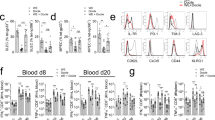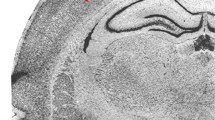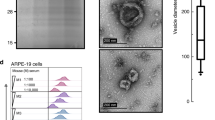Abstract
Recently presented evidence indicates that synthesis of defective interfering (DI) particles following infection of cultured cells with lymphocytic choriomeningitis (LCM) virus may result in self-curing1. The genesis of DI particles can occur in cells infected with virtually any animal virus2, and seems to be a host-controlled function3. Thus, these particles may represent a third line of defence—with the immune response and interferon—against virus invasion3,4. LCM virus infection causes the rapid appearance of DI particles in tissue culture cells5,6. Nevertheless, persistent infections can be easily established with LCM and other arenaviruses7–9. The LCM-persistent infections are apparently maintained in these cultures by the genesis of DI-resistant viruses1. This latter finding prompted us to determine whether such DI-resistant viruses occur in nature. Vertical transmission of LCM virus in the house mouse or neonatal infection of laboratory mice takes the form of a life-long inap-parent infection. These mice lack functional virus-specific T lymphocytes, but may make an antibody response against the invasion. It is known that LCM virus injected into a neonatal mouse can change during the course of the infection so that at least two different viral populations coexist in the same mouse10. DI particles are produced in abundance shortly after neonatal infection and this precedes the appearance of a virus population that, by plaque morphology, differs from the one originally inoculated11. We report here the isolation of an LCM virus from persistently infected mice that is resistant not only to the DI particles which were produced shortly after neonatal infection with heterotypic virus but also to the DI particles that this virus itself induces in neonates. We know of no other report of viruses which can replicate normally in the presence of the DI particles they induce.
This is a preview of subscription content, access via your institution
Access options
Subscribe to this journal
Receive 51 print issues and online access
$199.00 per year
only $3.90 per issue
Buy this article
- Purchase on Springer Link
- Instant access to full article PDF
Prices may be subject to local taxes which are calculated during checkout
Similar content being viewed by others
References
Jacobson, S., Dutko, F. J. & Pfau, C. J. J. gen. Virol. 44, 113–121 (1979).
Huang, A. S. & Baltimore, D. Comprehensive Virology (eds Fraenkel-Conrat, H. & Wagner, R. R.) 73–116 (Plenum, New York, 1977).
Kang, C. Y., Glimp, T. & Allen, R. Negative Strand Viruses and the Host Cell (eds Mahy, B. W. J. & Barry, R. D.) 501–513 (Academic, London, 1978).
Huang, A. S. & Baltimore, D. Nature 226, 325–327 (1970).
Welsh, R. M. & Pfau, C. J. J. gen. Virol. 14, 177–187 (1972).
Pfau, C. J. Medicina, B. Aires 37, 32–38 (1977).
Staneck, L. D., Welsh, R. M., Trowbridge, R. S., Wright, E. A. & Pfau, C. J. Infect. Immun. 6, 444–450 (1972).
Boxaca, M. C. Medicina, B. Aires 30, 50–61 (1970).
Dutko, F. J., Wright, E. A. & Pfau, C. J. J. gen. Virol. 31, 417–427 (1976).
Hotchin, J. Monogr. hum. Genet. 6, 172–181 (1972).
Popescu, M. & Lehmann-Grube, F. Virology 77, 78–83 (1977).
Pulkkinen, A. J. & Pfau, C. J. Appl. Microbiol. 20, 123–128 (1970).
Hotchin, J., Benson, L. M. & Seamer, J. Virology 18, 71–78 (1962).
Dutko, F. J. & Pfau, C. J. J gen. Virol. 38, 195–208 (1978).
Welsh, R. M., O'Connell, C. M. & Pfau, C. J. J. gen. Virol. 17, 355–359 (1972).
Popescu, M., Schaefer, H. & Lehmann-Grube, F. J. Virol. 20, 1–8 (1976).
Welsh, R. M. & Buchmeier, M. J. Virology 96, 503–515 (1979).
Popescu, M. & Lehmann-Grube, F. J. gen. Virol. 30, 113–122 (1976).
Cole, G. A., Nathanson, N. & Prendergast, R. A. Nature 238, 335–337 (1972).
Doherty, P. C. & Zinkernagel, R. M. J. Immun. 114, 30–33 (1976).
Cole, G. A., Prendergast, R. A. & Henney, C. S. Lymphocytic Choriomeningitis Virus and Other Arenaviruses (ed. Lehmann-Grube, F.) 61–71 (Springer, Berlin, 1973).
Welsh, R. M. & Oldstone, M. B. A. J. exp. Med. 145, 1449–1468 (1977).
Author information
Authors and Affiliations
Rights and permissions
About this article
Cite this article
Jacobson, S., Pfau, C. Viral pathogenesis and resistance to defective interfering particles. Nature 283, 311–313 (1980). https://doi.org/10.1038/283311a0
Received:
Accepted:
Issue Date:
DOI: https://doi.org/10.1038/283311a0
This article is cited by
Comments
By submitting a comment you agree to abide by our Terms and Community Guidelines. If you find something abusive or that does not comply with our terms or guidelines please flag it as inappropriate.



